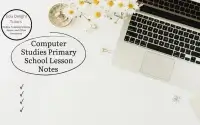Tools, Their Uses, and How to Care for Them Vocational Aptitude Primary 1 First Term Lesson Notes Week 3
Vocational Aptitude Lesson Plan for Primary 1 – First Term – Week 3
Subject: Vocational Aptitude
Class: Primary 1
Term: First Term
Week: 3
Age: 6 years
Topic: Tools, Uses, and Maintenance
Sub-topic: Proper Use and Care of Tools
Duration: 40 minutes
Behavioural Objectives
By the end of the lesson, pupils should be able to:
- Identify various tools.
- State the uses of different tools.
- Explain how to maintain tools properly.
Keywords
- Tool: A device used for specific work.
- Maintenance: The act of keeping something in good condition.
- Scissors: A tool for cutting materials.
- Pliers: A tool for cutting and joining wires.
- Lubricant: A substance applied to reduce friction and prevent rust.
Set Induction
The teacher shows a few tools like scissors and a hammer, and asks pupils if they know what these tools are used for.
Entry Behaviour
Pupils may have seen their parents or teachers use tools like scissors and hammers at home or in school.
Learning Resources and Materials
- Real tools (e.g., scissors, hammer, pliers).
- Picture charts of different tools.
Building Background / Connection to Prior Knowledge
Ask pupils to talk about any tools they have seen before and what they think the tools are used for.
Embedded Core Skills
- Observation skills.
- Identification of tools and their functions.
Learning Materials
- Lagos State Scheme of Work for Vocational Aptitude.
Instructional Materials
- Sample tools for demonstration (e.g., scissors, pliers, hammer).
- Picture charts showing tools.
Content
Tools and Their Uses
- Scissors
- Use: For cutting materials like clothes, leather, and paper.
- Storage: Keep them clean and dry.
- Pliers
- Use: For cutting and joining wires.
- Storage: Keep clear and dry.
- Hammer
- Use: For driving nails into wood.
- Storage: Keep clean and dry.
- Saw
- Use: For cutting wood, metals, and pipes.
- Storage: Keep in a dry place.
- Cutlass
- Use: For cutting grasses.
- Storage: Clean after use and keep in a dry place.
- Shovel
- Use: For mixing and moving sand.
- Storage: Clean after use and keep dry.
- Spanner
- Use: For loosening and tightening bolts.
- Storage: Keep away from water, clean, and dry.
- Ladder
- Use: For climbing heights such as walls.
- Storage: Clean and keep dry.
Tool Maintenance
- Keep tools away from water to prevent rust.
- Apply lubricants to metal tools to avoid rusting.
- Always clean tools after use and store them in a dry place.
Evaluation:
- Scissors are used for cutting ___.
a. Paper
b. Wood
c. Metal
d. Sand - Pliers are used to cut and join ___.
a. Cloth
b. Wire
c. Food
d. Plastic - A hammer is used to drive ___ into wood.
a. Nails
b. Screws
c. Wires
d. Bolts - The saw is used for cutting ___.
a. Paper
b. Metal
c. Plastic
d. Bolts - The cutlass is used for cutting ___.
a. Grass
b. Wood
c. Wire
d. Paper - A shovel is used for mixing and moving ___.
a. Water
b. Sand
c. Nails
d. Clothes - A spanner is used to tighten and loosen ___.
a. Bolts
b. Nails
c. Grass
d. Paper - A ladder is used for ___.
a. Digging
b. Climbing
c. Cutting
d. Measuring - Tools should be kept away from ___.
a. Water
b. Air
c. Sand
d. Oil - We should apply ___ to metal tools to prevent rusting.
a. Water
b. Sand
c. Lubricant
d. Paper
Class Activity Discussion :
- What is a tool?
- A tool is a device used to do work.
- What are scissors used for?
- Scissors are used for cutting materials like paper or cloth.
- What do pliers do?
- Pliers are used for cutting and joining wires.
- What is the use of a hammer?
- A hammer is used for driving nails into wood.
- What is a saw used for?
- A saw is used to cut wood, metals, and pipes.
- What is the use of a cutlass?
- A cutlass is used for cutting grasses.
- What does a shovel do?
- A shovel is used for mixing and moving sand.
- What is a spanner used for?
- A spanner is used for loosening and tightening bolts.
- What is a ladder used for?
- A ladder is used for climbing heights.
- Why should tools be kept away from water?
- To prevent rusting.
- How can we maintain metal tools?
- By applying lubricants to avoid rust.
- What should we do after using tools?
- Clean them and store them in a dry place.
- Why is it important to keep tools dry?
- To prevent them from rusting or getting damaged.
- What tool is used to cut paper?
- Scissors.
- Can a spanner be used to cut things?
- No, it is used to tighten and loosen bolts.
Presentation
Step 1: The teacher revises the previous topic on “Types of Tools.”
Step 2: The teacher introduces the new topic “Tools, Uses, and Maintenance,” explaining the proper use and care of tools.
Step 3: The teacher allows pupils to examine tools and discuss their uses and how to maintain them.
Teacher’s Activities
- Show real tools or pictures of tools.
- Explain how each tool is used and how to take care of them.
- Demonstrate cleaning and storing tools after use.
Learners’ Activities
- Pupils will identify tools and discuss their uses.
- Pupils will demonstrate how to maintain tools by cleaning and storing them.
Assessment:
- What is the use of scissors?
- How do we maintain a hammer?
- Name two tools used for cutting.
- Why should tools be kept away from water?
- What is a spanner used for?
- How can we prevent metal tools from rusting?
- What should you do after using a shovel?
- Name a tool used for cutting grasses.
- What is the use of a ladder?
- Why should tools be kept clean?
Conclusion
The teacher moves around the class, checking pupils’ understanding of the uses and maintenance of tools, giving feedback where necessary.

